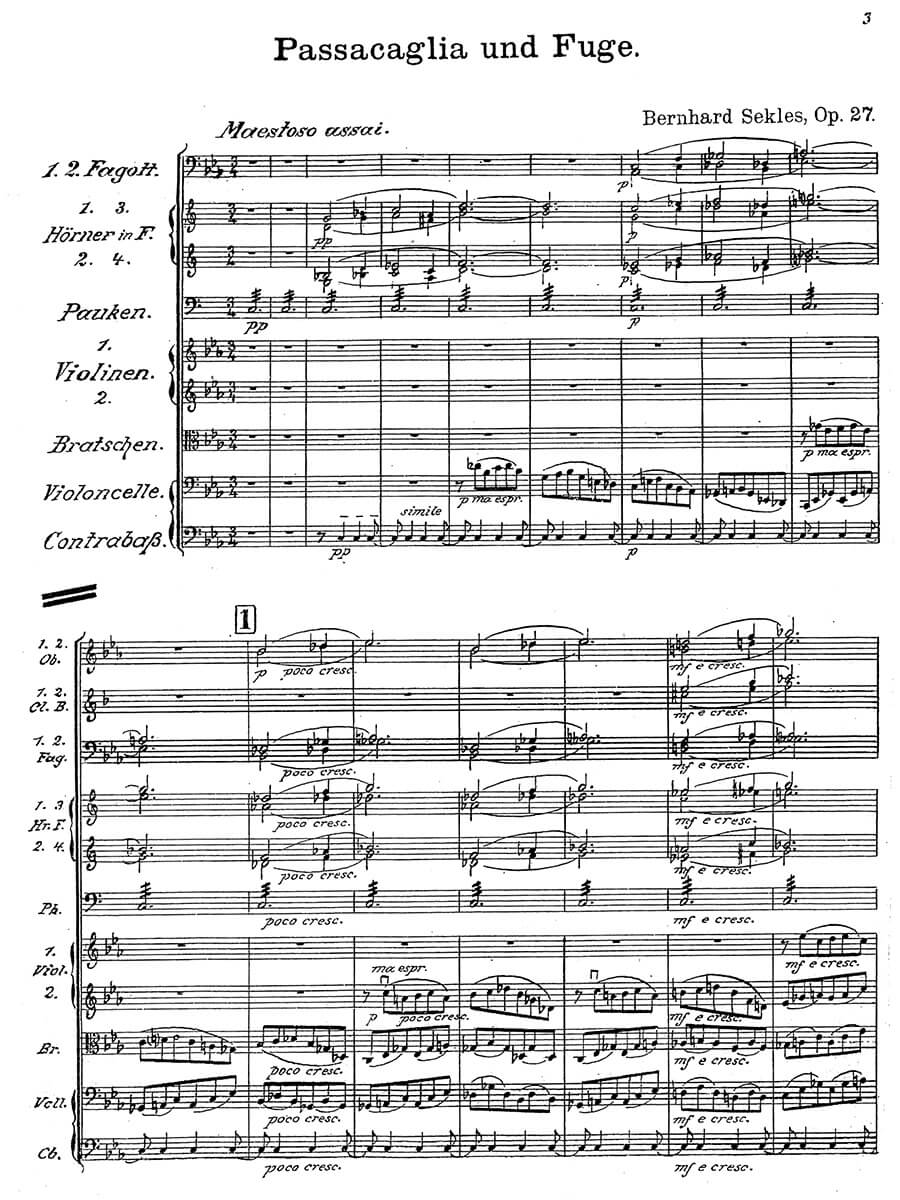Passacaglia and Fugue for large orchestra and organ Op. 27
Sekles, Bernhard
21,00 €
Preface
Bernhard Sekles – Passacaglia und Fuge für großes Orchester und Orgel Op. 27
(b. Frankfurt, 20 March [or: 20 June] 1872 – d. Frankfurt, 8 December 1934)
Preface
In his monograph on Bernhard Sekles published in 2005, Joachim Tschiedel rightfully maintained that the composer and pedagogue stood “on the verge of total oblivion.” Fortunately, since then there have been initiatives for the reintroduction of Sekles’s work to contemporary audiences, a very significant one being the publication of his scores in the Repertoire Explorer series. Although Sekles’s compositions still remain largely outside the standard classical repertoire, artistic and scholarly interest in this important German composer has surely been growing.
Born in Frankfurt in 1872 and aware since “earliest childhood”, as he mentioned in an autobiographical note, that he “wished to know nothing else except music” (Sekles: 245), Sekles studied piano and composition at the Hoch Conservatory in Frankfurt. Upon graduation, he first worked as a theatre-conductor in Heidelberg and Mainz, and in 1896 he accepted a teaching position at the Hoch Conservatory, where he taught theory and subsequently counterpoint, form, instrumentation, and composition. From 1923 to 1933 he was director of the Hoch Conservatory, before being removed from his post by the Nazi regime. During Sekles’s tenure several important innovations were introduced to the curriculum of the Conservatory.
In parallel to his successful administrative and teaching career (his students included Paul Hindemith, Rudi Stephan and Hans Rosbaud), Sekles was one of the prominent composers of his time and, until 1933, his works, which included stage, orchestral, chamber and vocal music, were frequently performed across Europe. His orchestral oeuvre, in particular, includes such important compositions as Die Temperamente Op.25, Gesichte Op.29, Der Dybuk Op.35, Symphony No.1 Op.37, and the present work.
Passacaglia und Fuge für großes Orchester und Orgel Op.27 was completed in October 1917 and was dedicated to Carl Hagemann, who directed Sekles’s opera Scheherazade in Mannheim. It was premiered on 13 January 1922, at a concert of the Frankfurt Museum Society under the direction of Wilhelm Furtwängler, along with Johannes Brahms’s Piano Concerto No.2 and Richard Strauss’s Sinfonia Domestica (Tschiedel: 54). Other performances soon followed: later in the same year in Bremen, at a concert of the Philharmonic Society, and another in December 1922, during the Deutsche Musikwoche in Munich. Early criticism praised the composition’s “skilful handling of themes and motives” (Musical America), while Karl Westermeyer deemed Passacaglia und Fuge Op.27 a work of great significance (Tschiedel: 55).
Maria Theofili, 2023
Bibliography
“Frankfurt Hears Pfitzner Work.” Musical America, March 4, 1922.
“Konzerte.” Die Musik XV/I (1922-3): 234-5.
Nüßle, Hermann. “[Musikleben] München”. Die Musik XV/I (1922-3): 391.
Rectanus, Hans. “Bernhard Sekles.” In Die Musik in Geschichte und Gegenwart, 2nd edition
(Kassel: Bärenreiter, 1994–2008), Personenteil 15: 548-50.
Sekles, Bernhard. “Bernhard Sekles 1872-”. In Composers of Today, edited by David Ewen,
245-6. New York: H.W. Wilson, 1934.
Tschiedel, Joachim. Bernhard Sekles (1872–1934). Leben und Werk des Frankfurter
Komponisten und Pädagogen. Schneverdingen: Verlag für Musikbücher. Karl Dieter Wagner, 2005.
For performance material please contact Leukart, Munich.
Deutsches Vorwort lesen … > HERE
Score Data
| Edition | Repertoire Explorer |
|---|---|
| Score Number | 4840 |
| Genre | Solo Instrument(s) & Orchestra |
| Pages | 60 |
| Size | 210 x 297 mm |
| Printing | Reprint |
